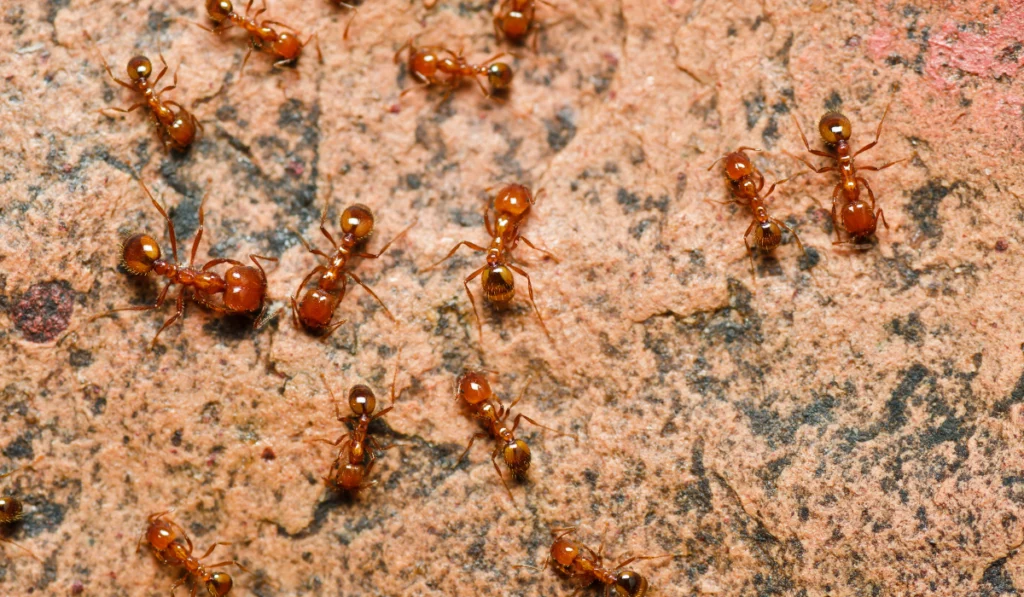A Complete Guide to Ant Species in California
What makes California a haven for so many different ant species? The unique climate and diverse ecosystems provide a perfect environment for over 270 ant species to thrive.
From home invasions to ecological impacts, they are notable in the state’s environment. Keep reading to learn about the most common species and best ant control strategies.
Key Takeaways
- California has many native and invasive ant species with different behaviors and habitats.
- Species like carpenter ants can damage wood and sting, while invasive ants like Argentine ants compete with local species.
- Red imported and southern fire ants are dangerous because their stings can cause pain and allergic reactions.
- You can manage ant infestations by cleaning food areas, using bait stations, or calling pest control if the problem continues.
Native Ant Species in California
California hosts various species of ants, each with unique behaviors and habitat preferences. These insects are essential in the ecosystem, contributing to nutrient cycling and pollination.
Carpenter Ants

Carpenter ants, part of the Camponotus genus, are widely recognized in California. They are often mistaken for termites due to their wood-nesting habits but only cause damage by creating tunnels in damp or decaying wood. These ants are known for their considerable size, often reaching up to half an inch.
Velvety Tree Ants

Velvety tree ants, or Liometopum occidentale, present a smooth, velvety texture. These ants exhibit aggressive behavioral traits, especially when defending their colonies. Their bites can be painful and release a distinct odor when disturbed. They create visible trails along tree branches in search of food.
Harvester Ants

Harvester ants are renowned for their seed-gathering activities. They are a familiar sight in the arid landscapes of California. These species construct nests with distinctive gravel or pebble coverings. Due to their sting, they can pose a mild threat if disturbed.
Southern Fire Ants

Southern fire ants are an adaptable and opportunistic type of ants. Their colonies can be found in lawns or gardens. If left unchecked, these ants in reddish-brown hue can quickly become a nuisance. Though tiny, their sting packs a punch, causing discomfort or allergic reactions in some cases.
Invasive Ant Species in California
Besides the native ones, California hosts several invasive ants, posing ecological challenges. Each has unique traits and impacts on the environment and human activities.
Argentine Ants

Argentine ants are one of the most notable invaders in California. They came from South America and have created supercolonies, disrupting native ecosystems. These ants are aggressive, competing with local species for resources. Often, they win due to their large populations.
Red Imported Fire Ants

Red imported fire ants are infamous for their painful stings. Their aggressive swarming behavior can overwhelm small animals and other insect species. Originating from South America, they have established themselves worldwide, including California.
Pharaoh Ants

The Pharaoh ant, another common invasive species, prefers indoor environments. These ants are troublesome in hospitals because they can spread pathogens, affecting human health. Because they can quickly form new colonies, they adapt well to changing conditions.
Odorous House Ants

Odorous house ants are named for the peculiar scent they emit when crushed. These ants thrive indoors and outdoors, making them versatile invaders in California. Despite their small size, these ants can disrupt kitchens by foraging for food and water.
Pavement Ants

Pavement ants typically dwell in urban areas, constructing nests in pavements and driveways. These ants are brown to black and can be seen foraging in long trails. Their nests can cause structural damage over time due to erosion beneath sidewalks and foundations.
Thief Ants

Thief ants are apt, as their name suggests. They are known for infiltrating other ants’ nests to steal food. These tiny, yellowish ants have an affinity for greasy and protein-rich foods. Their size allows them to enter buildings through tiny cracks and crevices, making them a persistent nuisance.
How Dangerous Are Ants in California?
While the most common ants in California are harmless, a few species can threaten humans, pets, and the ecosystem.
Red imported and southern fire ants are known for their painful stings, which can cause severe allergic reactions. While Argentine ants do not directly harm humans through stings or bites, they can displace native species.
Many of these social insects interact with other insects without harm. For example, their relationship with aphids highlights their role in the ecosystem. Worker ants protect aphids to maintain a supply of honeydew.
How to Get Rid of Ants in California
As homeowners, keeping your home ant-free can be a persistent challenge. Here’s how to create a less hospitable environment with the right pest management:
- Inspect windows, doors, and other openings to find where ants enter. Seal these entry points to prevent further ant infestations.
- Clean kitchens and dining areas by wiping down counters, sweeping floors, and storing food in airtight containers.
- Place ant bait stations near ant colonies to lure workers and reduce their numbers over time.
- Spray non-toxic products near ant nests to kill eggs, larvae, and adults, following local regulations for safety.
- Search areas like tree stumps, wall voids, and crevices for hidden ant nests and remove them.
- Use natural ant repellents to create barriers that deter ants without harmful active ingredients.
- Perform routine checks for other pests that can attract ants or provide them with food sources.
When to Call Pest Control for Ants in California
Ant problems can sneak up on you in the most unexpected ways. If repeated ant problems persist, you might need the help of pest control experts who can offer specialized treatments.
Besides ants, do you need help with other common pests, such as cockroaches, fleas, and termites? Visit our website today for a free estimate.



